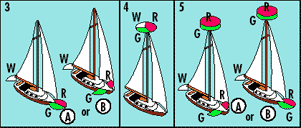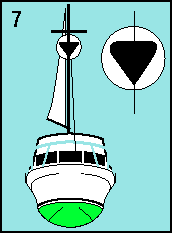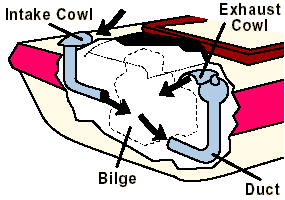| Equipment |
 |
|
 |
| Lighting |
|
All boats must show running lights between sunset and sunrise and during periods of restricted visibility. A sailboat operating under power or under power and sail must display the proper lights for a powerboat. This section describes the inland and international light requirements for boats less than 20 meters (65 feet 7 inches). In many cases, the lights prescribed for a particular boat are the same under both rules. Any exceptions are noted.
Power Driven Boats
On inland and international waters, a power-driven boat shall exhibit navigation lights as shown in 1. Vessels less than 12 meters (39 feet 4 inches) may show the lights shown in 1 or 2. In international waters a power-driven boat of less than 7 meters (23 feet) in length whose maximum speed cannot exceed 7 knots may exhibit an all-round white light and if practicable, also exhibit side lights.
Sailboats and Boat Under Oars
NOTE: A sailboat under machinery power and sail is considered a power-driven boat.
 Sailboats under sail alone must exhibit navigation lights shown in 3, 4 or 5. A sailboat of less than 7 meters (23 feet) in length may carry an electric torch or lighted lantern showing a white light which shall be exhibited in sufficient time to prevent collision (see figure 6c). Sailboats under sail alone must exhibit navigation lights shown in 3, 4 or 5. A sailboat of less than 7 meters (23 feet) in length may carry an electric torch or lighted lantern showing a white light which shall be exhibited in sufficient time to prevent collision (see figure 6c).
A boat under oars may: (a) display those lights prescribed for sailboats or (b) have ready at hand an electric torch or lighted lantern showing a white light which shall be exhibited in sufficient time to prevent collision (see figure 6).
Anchor Lights
 Power-driven boats and sailboats at anchor must display anchor lights. An anchor light is an all-round white light visible for 2 miles and exhibited forward where it can best be seen. Vessels less than 7 meters (23 feet) are not required to display anchor lights unless anchored in or near a narrow channel, fairway, or anchorage, or where other vessels normally navigate. Anchor lights are not required on vessels less than 20 meters anchored in a special anchorage area designated by the Secretary of Transportation. Power-driven boats and sailboats at anchor must display anchor lights. An anchor light is an all-round white light visible for 2 miles and exhibited forward where it can best be seen. Vessels less than 7 meters (23 feet) are not required to display anchor lights unless anchored in or near a narrow channel, fairway, or anchorage, or where other vessels normally navigate. Anchor lights are not required on vessels less than 20 meters anchored in a special anchorage area designated by the Secretary of Transportation.
Day Shape
 Vessels under sail also being propelled by machinery must exhibit forward, where it can best be seen, a conical shape, apex down (See Figure 7). Vessels less than 12 meters are not required to exhibit the day shape in inland waters. Vessels under sail also being propelled by machinery must exhibit forward, where it can best be seen, a conical shape, apex down (See Figure 7). Vessels less than 12 meters are not required to exhibit the day shape in inland waters.
Automotive Equipment
Equipment such as starter motors, alternators/generators and air cleaners are not intrinsically safe and should not be used in gasoline powered boats.
VENTILATION (Fuel Vapors)
Any boat using a fuel with a flashpoint of 110 (degrees) or less (gasoline, but not diesel) that has any enclosed engine or fuel tank spaces (not open to the atmosphere) must have an efficient ventilation system to disperse  explosive gases. Natural ventilation consists of at least two ventilation ducts fitted with cowls or their equivalent. At least one exhaust duct extending to the lower portion of the bilge and at least one intake (supply) duct extending to a point midway to the bilge or at least below the level of the carburetor air intake is required. Boats built after July 31, 1980 are required to have powered ventilation (exhaust blower) for engine compartments that are not open to the atmosphere. Such boats are required to display a warning label such as this: explosive gases. Natural ventilation consists of at least two ventilation ducts fitted with cowls or their equivalent. At least one exhaust duct extending to the lower portion of the bilge and at least one intake (supply) duct extending to a point midway to the bilge or at least below the level of the carburetor air intake is required. Boats built after July 31, 1980 are required to have powered ventilation (exhaust blower) for engine compartments that are not open to the atmosphere. Such boats are required to display a warning label such as this:
“Warning - gasoline vapors can explode. Before starting engine operate blower for 4 minutes and check engine compartment bilge for gasoline vapors. Gas vapors contained in an enclosed space make a boat a potential bomb waiting to go off!”
Note: Check the galley! Butane and propane are even more dangerous than gasoline. Heavier than air, they flow rapidly into the lower part of the boat and are extremely difficult to remove. If you cook with a liquid petroleum gas such as propane or butane, be sure the fuel tank enclosure is properly ventilated.
RECOMMENDED EQUIPMENT
Along with the required equipment, the State Marine Board recommends carrying the following:
1. Compass
2. Anchor
3. Fenders
4. Flashlight
5. Line
6. Bucket
7. Bilge Pump & Pads
8. First Aid Kit
9. Paddle
10. Tool Kit
11. Two Way Radio
12. Distress Signals*
|
|
|
|
